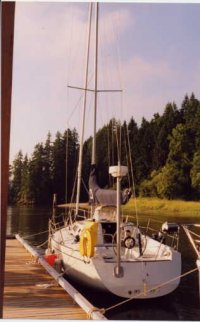Nothing about a radar installation is without compromise(s).
It's a popular misconception...as John has noted, that the higher the R/T is mounted the better. I thought long and hard about where to put my antenna (backstay with Questus "lateral gimbal") and put it where I did for the following reasons: when you're talking about a 2KW system in the 1st place, usually expressed as 24mi, 32mi, etc., you don't increase the maximum range signifigantly by merely raising the height. What you look for is a height above the water just high enough to fit your maximun observable distance into the distance your display can show you in the first place...in other words, if you've got a 2KW, 24mi. radar, you won't improve it's performance (and why would you want to?) by putting the antenna at, let's say, at the 2nd spreader. If 24 miles is what the system is capable of, then that's what you get...and that's a nice figure for any sailboat on the Bay.
The 1st spreader height on Sea Quest is 19 ft, as Garth has previously noted, and I suspect that my 30' cable would still be shy by about 5' or so to my display. Just a guess, I didn't measure the distance...but it's critical. The height would have worked for me, but the cable is a bear...also as you have noted and, since the mast is stepped on the roof, I would have had to cut the cable and insert a connector(s) at the base. I am licensed and certified to do that sort of thing commercially (it's my nite job) and I say that it is NOT as trivial as splicing wires. It can be done, but it's a son-of-a-gun and very expensive.
The pole mount appealed to me at first, but then I got to thinking that both the backstay and pole would put the height about the same (about 12' or thereabouts) and that height diminishes considerably as the boat heels; the cable length would be about the same (you coil up the excess, if any, and stuff it somewhere); but the Questus at least keeps the antenna level. I'm not sure what benefit there is to that if the boat is heeled and the actual height at that point is reduced to about 7-8'. A disadvantage of the Questus is that the combined weight of the assembly, Questus + Sitex, about 17 lbs., although partially borne by the backstay pole when vertical, causes noticeable sag when off vertical. Not an issue, probably, but I've learned to pay attention to words like probably, almost, virtually, etc.
Anyway, the installation is aesthetcially pleasing, functionally perfect(except for height) and has been problem free for several years. I've got pics if anyone is interested.


